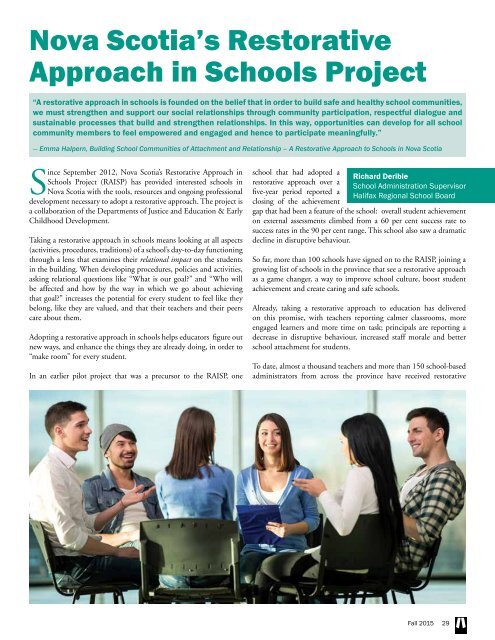Restoring Justice
1OTNXPx
1OTNXPx
You also want an ePaper? Increase the reach of your titles
YUMPU automatically turns print PDFs into web optimized ePapers that Google loves.
Nova Scotia’s Restorative<br />
Approach in Schools Project<br />
“A restorative approach in schools is founded on the belief that in order to build safe and healthy school communities,<br />
we must strengthen and support our social relationships through community participation, respectful dialogue and<br />
sustainable processes that build and strengthen relationships. In this way, opportunities can develop for all school<br />
community members to feel empowered and engaged and hence to participate meaningfully.”<br />
— Emma Halpern, Building School Communities of Attachment and Relationship – A Restorative Approach to Schools in Nova Scotia<br />
Since September 2012, Nova Scotia’s Restorative Approach in<br />
Schools Project (RAISP) has provided interested schools in<br />
Nova Scotia with the tools, resources and ongoing professional<br />
development necessary to adopt a restorative approach. The project is<br />
a collaboration of the Departments of <strong>Justice</strong> and Education & Early<br />
Childhood Development.<br />
Taking a restorative approach in schools means looking at all aspects<br />
(activities, procedures, traditions) of a school’s day-to-day functioning<br />
through a lens that examines their relational impact on the students<br />
in the building. When developing procedures, policies and activities,<br />
asking relational questions like “What is our goal?” and “Who will<br />
be affected and how by the way in which we go about achieving<br />
that goal?” increases the potential for every student to feel like they<br />
belong, like they are valued, and that their teachers and their peers<br />
care about them.<br />
Adopting a restorative approach in schools helps educators figure out<br />
new ways, and enhance the things they are already doing, in order to<br />
“make room” for every student.<br />
In an earlier pilot project that was a precursor to the RAISP, one<br />
school that had adopted a<br />
restorative approach over a<br />
five-year period reported a<br />
closing of the achievement<br />
Richard Derible<br />
School Administration Supervisor<br />
Halifax Regional School Board<br />
gap that had been a feature of the school: overall student achievement<br />
on external assessments climbed from a 60 per cent success rate to<br />
success rates in the 90 per cent range. This school also saw a dramatic<br />
decline in disruptive behaviour.<br />
So far, more than 100 schools have signed on to the RAISP, joining a<br />
growing list of schools in the province that see a restorative approach<br />
as a game changer, a way to improve school culture, boost student<br />
achievement and create caring and safe schools.<br />
Already, taking a restorative approach to education has delivered<br />
on this promise, with teachers reporting calmer classrooms, more<br />
engaged learners and more time on task; principals are reporting a<br />
decrease in disruptive behaviour, increased staff morale and better<br />
school attachment for students.<br />
To date, almost a thousand teachers and more than 150 school-based<br />
administrators from across the province have received restorative<br />
Fall 2015 29


